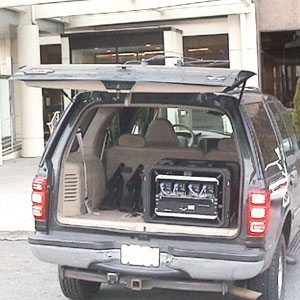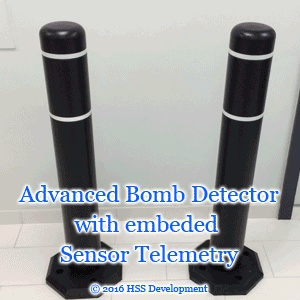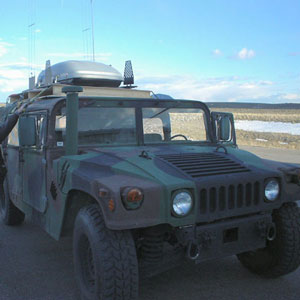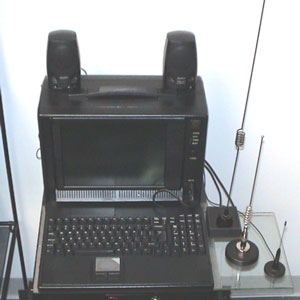The RDS-1000 is a radiation monitoring system used to detect gamma radiation in excess of local background radiation. The system can be set to “alarm” at a preset level. Notification of radiation in excess of this level triggers an alarm, identifies the offending isotope, photographs the perpetrator, records the event data, and notifies the system’s supervisor of the incident.
It is built as a dirty bomb detector that is self contained. However, additional external detectors can interface with the system, expanding the radiation detection field, giving the user more coverage than other radiation detection products available.
Therefore, if the user has more than one entrance to a room, hallway, floor, or building, the radiation detector the chances of detecting a dirty bomb increase. The more radiation detectors deployed, the easier it is for an operator to receive an alert of the presence of a dirty bomb close or far away.
The system contains an internal 2” x 2” Sodium Iodide scintillation detector and a nuclear processor, supported by a 256-channel analyzer. A high resolution digital camera provides photograph(s) of each event triggering the system. Automatic calibration and built-in performance evaluations provide system reliability. Background radiation is automatically subtracted from all counting functions, providing corrected count sampling at one second intervals.
The alarm trigger threshold level is set automatically for two (2) times background or can be manually set to another desired level. The counting circuitry has a 1 millisecond response time to a detected event.
The RDS-1000 can be used in hospital environments and other locations where diagnostic isotopes may be present in patients passing near the system’s detector. Energy levels below those typically used in clinical practice (those below 500 KeV) are ignored, being treated as normal environmental background. They will not trigger the system’s alarm.
In the event higher energies are detected the Monitor automatically switches to the 1 MeV range, acquires a spectrum, identifies the isotope, activates Audio/Visual alarms, photographs the area, logs the event and can wirelessly notify specific individuals responsible for the system. When the count rate returns to its normal background level, the system reverts to its Area monitoring mode.
A built in red strobe with a visible range of up to ½ mile and an audio alarm are activated when the alarm trigger threshold is exceeded. This feature may be disabled via menu selection. In either case, a report is recorded in an event log on the hard drive. The logged incident report may be viewed at anytime at the monitor. The log contains the following information for each event: time and date, count levels, threshold setting, Multi-Channel spectrum, isotope identity and a photograph or multiple photographs of the violator.
This log may be transmitted via the internet, direct cable connection or manually extracted with a flash drive.
The available modes of operation are as a continuous radiation monitor, a “sleeping watchdog” monitor becoming active only upon a violation, and a latching monitor requiring a supervisor to reset the monitor after an event occurs. In all cases, each event is recorded in the event log.
A lockable NEMA security enclosure provides a tamper and water resistant container for the electronics and internal detector. Password protection prevents unauthorized access to the system’s software via the touch screen display.
Once the desired set-up is completed, the system will operate without operator intervention. The set-up procedure requires no computer skill and is user friendly. When the power is turned on, a diagnostic routine is initiated, a background reading is acquired and the monitor mode begins to cycle displaying counting information at 1 second intervals.
If a count exceeds the preset threshold level, the alarms will be activated, time and date stamp applied, photograph(s) taken, isotope is identified and an event report is sent to the system’s hard drive for permanent storage. If the system is not in the Latching mode, normal counting will return as soon as the high activity is no longer present. In the Latching mode, the supervisor is required to enter a password to reset the system.
The RDS-1000 can accommodate up to 8 external detectors, with or without the internal detector. This facilitates the monitoring of multiple portals or areas with a single SSR -7000 system. A dedicated camera can be paired to each detector. Report information is then linked to the specific detector that captures the violation.
All of the above features can be retrieved via the systems on board computer, with a data base for easy access to alarms and images. This system can be remotely monitored and supervised from any where in the world via an Ethernet connection.
The RDS-1000 microprocessor allows maximum system flexibility. The Windows operating system and associated hardware provide a stable and user-friendly system. The touch screen LCD display permits instructions to be entered as required by tapping the touch screen display in the locations prompted by the computer.





